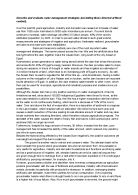Describe and evaluate water management strategies (excluding those directed at flood control).
Describe and evaluate water management strategies (excluding those directed at flood control).
Over the past 60 years agriculture, industry and domestic use caused an increase of water use from 1000 cubic kilometers to 5000 cubic kilometers per annum. If current trends continue to increase, water shortage will affect 3.5 billion people, 48% of the world’s estimated population, by 2025. In order to prevent water stress to such great extend, measurements and strategies of irrigation and agriculture, freshwater wetland, groundwater and damns and reservoirs were established.
Dams and reservoirs certainly are one of the most important water management strategies. The barrier placed across the river Nile and the artificial store that lies right behind the dam together make the Aswan Dam, lying south of the city Aswan in Egypt.
Hydroelectric power generation is water being stored behind the dam that drives the turbines and accounts for 45% of Egypt’s energy needed. Moreover, the dam provides water to crops during dry seasons, in times of drought or water scarcity and has irrigated an estimated of 3.4 million hectares of land, which lead to an increasing profit of Egypt’s economy. As well, the Aswan Dam is used to regulate the fall of the Nile up – and downstream, having a better outcome on the navigation of Lake Nasser and on tourism, as the dam became an important tourist attraction of Egypt. In addition, the dam enables water transfer to other rivers, which then can be used for municipal, agricultural and industrial purposes and enables more job possibilities.
Although the Aswan dam has a very positive outcome on water management, it has its limitations as well, since about 100,000 indigenous Egyptians were forced to move, as the area was needed to build the dam. Plus, the Nile has a higher evaporation rate than before as the water is not continuously floating, which lead to a decrease of 10% of the river’s water. Over and above the fact of evaporation, there is a deposition of sediment in progress in the Lake Nasser, which resulted with an estimated 100 million tonnes each year and causes a depth reduction of the lake leading to less storable amount of water and may also hinder nutrients from reaching farmland, which therefore reduces agricultural progress. The standstill of the water caused the death of many fish and lead to 3,000 unemployed, as the sardines (fish) no longer survived.
Furthermore, despite the huge amount of money, $1 billion, invested into the dam, poor management has increased the salinity of the water and soil, which reduced crop yields by one third in some areas.
Besides the factors being affected by the Aswan Dam negatively, the positive outcomes yet overweight and support the dam’s existence.









